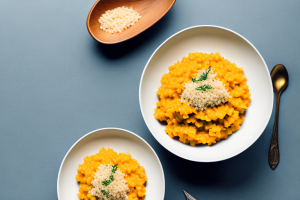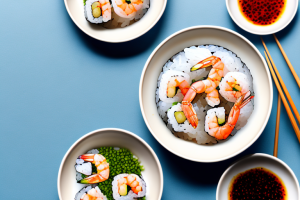How to prepare sushi rice with avocado
9 min read
A bowl of sushi rice with avocado slices on top
Sushi rice is the foundation of any good sushi roll, and adding avocado to this classic ingredient takes it to another level. Avocado has a rich and creamy texture that pairs deliciously with the slightly sweet and tangy taste of sushi rice. In this comprehensive guide, we will cover all the steps and tips you need to know to make the perfect homemade avocado sushi roll.
The benefits of adding avocado to sushi rice
Not only does avocado add a unique texture and flavor to sushi rolls, it also has countless health benefits. Avocado is loaded with healthy fats, fiber, and essential vitamins and minerals. Adding it to sushi rice increases the nutritional value of the dish and makes it more satisfying and filling.
One of the key benefits of avocado is its high content of monounsaturated and polyunsaturated fats, which are known to help reduce bad cholesterol levels and lower the risk of heart disease. Additionally, avocado is a great source of potassium, which helps regulate blood pressure and maintain healthy kidney function.
Another benefit of adding avocado to sushi rice is that it can help improve digestion. The fiber in avocado helps promote regular bowel movements and can prevent constipation. It also helps keep you feeling full for longer periods of time, which can help prevent overeating and promote weight loss.
Choosing the right type of rice for sushi
When it comes to making sushi, rice selection is key. Sushi rice, or Japanese short-grain rice, is the best option for making sushi. The grains are round and plump, with a sticky texture that helps the rice hold together when rolled. It’s important to rinse the rice thoroughly before cooking to remove excess starch and prevent the rice from becoming too sticky.
Another important factor to consider when choosing sushi rice is the quality. Look for rice that is labeled as “sushi rice” or “short-grain rice” and avoid using long-grain rice or other types of rice, as they won’t have the same texture and stickiness needed for sushi. Additionally, consider purchasing rice from a reputable source, as the quality of the rice can greatly affect the taste and texture of your sushi.
Essential kitchen tools for preparing sushi rice with avocado
To make homemade sushi rolls, you will need a few essential kitchen tools. These include a rice cooker or pot, a sharp knife, a cutting board, a bamboo sushi mat, and a bowl of cold water to moisten your hands when handling the sticky rice.
Additionally, if you plan on adding avocado to your sushi rolls, you will need a ripe avocado, a spoon, and a small bowl of water with a squeeze of lemon juice to prevent the avocado from browning. It’s important to slice the avocado thinly and evenly to ensure that it rolls well with the rice and other ingredients.
Step-by-step guide to cooking sushi rice for avocado rolls
Begin by washing the rice until the water runs clear. Then, add the rice and water to your rice cooker or pot according to the manufacturer’s instructions. Once cooked, let the rice rest for 10-15 minutes before seasoning with vinegar, sugar, and salt.
It’s important to note that the ratio of rice to water is crucial for achieving the perfect texture of sushi rice. Generally, the ratio is 1:1.25, meaning for every cup of rice, you’ll need 1.25 cups of water. However, this may vary depending on the type of rice and your personal preference. Experiment with different ratios to find what works best for you.
Tips for seasoning sushi rice with vinegar and sugar
Vinegar, sugar, and salt are the key ingredients for seasoning sushi rice. A good rule of thumb is to use equal parts vinegar and sugar, and half the amount of salt. For example, if you’re using one cup of vinegar, use one cup of sugar and half a cup of salt. Mix the ingredients together until the sugar and salt have dissolved, then add to the warm cooked rice while stirring gently. Allow the rice to cool to room temperature before rolling.
It’s important to note that the type of vinegar you use can affect the taste of the sushi rice. Rice vinegar is the most commonly used vinegar for sushi rice, but you can also use other types of vinegar such as apple cider vinegar or white wine vinegar. However, keep in mind that using a different type of vinegar may alter the flavor of the rice. Experiment with different types of vinegar to find the taste that you prefer.
Preparing the avocado for sushi rolls: slicing and dicing techniques
To prepare the avocado for sushi rolls, start by cutting it in half and removing the pit. Then, use a spoon to scoop out the flesh and place it on a cutting board. Slice the avocado into even pieces, and then cut each piece into thin strips. Ensure that the slices are long enough to fit in your sushi rolls.
It is important to choose a ripe avocado for sushi rolls. A ripe avocado should be slightly soft to the touch and have a dark green color. If the avocado is too hard, it will be difficult to slice and may not have the desired texture in the sushi roll. On the other hand, if the avocado is too ripe, it may be too mushy and difficult to handle.
Another technique for preparing avocado for sushi rolls is to dice it into small cubes. This can be done by slicing the avocado into even pieces, and then cutting each piece into small cubes. This technique is especially useful for creating a filling with a more uniform texture. Additionally, diced avocado can be used as a topping for sushi rolls, adding a pop of color and flavor to the dish.
Combining the prepared sushi rice and avocado: rolling techniques
To roll sushi, place your prepared bamboo mat on a flat surface and cover it with a sheet of nori seaweed. Spread a thin layer of prepared sushi rice over the seaweed, leaving about an inch of space at the top. Arrange your avocado slices and other toppings in a line across the middle of the rice. Using the mat, roll the sushi tightly, pressing down gently to seal. Lift the mat away as you roll, and continue until you reach the end. Cut the sushi roll into even pieces with a sharp knife and serve.
It’s important to note that the temperature of the rice and avocado can affect the rolling process. If the rice is too hot, it can make the seaweed soggy and difficult to work with. Similarly, if the avocado is too cold, it can be hard to slice and may not stick to the rice. To ensure the best results, make sure your ingredients are at the appropriate temperature before beginning the rolling process.
Adding other ingredients to sushi rolls: fish, vegetables, and sauces
Experiment with other ingredients to add to your avocado sushi rolls. Try adding fresh fish like salmon or tuna, or veggies like cucumber or carrot. You can also add sauces like soy sauce, wasabi, or spicy mayo to enhance the flavors of your sushi rolls.
Another great ingredient to add to your sushi rolls is crab meat. It adds a sweet and savory flavor that pairs well with avocado. You can also try adding tempura shrimp for a crunchy texture. Don’t be afraid to get creative and try new combinations of ingredients to find your perfect sushi roll.
Serving suggestions for your homemade avocado sushi rolls
Serve your homemade avocado sushi rolls with soy sauce, pickled ginger, and wasabi on the side. Garnish with chopped scallions or sesame seeds for added flavor and texture.
For a complete meal, pair your avocado sushi rolls with a side of miso soup and a seaweed salad. You can also experiment with different fillings, such as cucumber, carrot, or tofu, to create a variety of sushi rolls. Don’t be afraid to get creative and try new combinations!
Frequently asked questions about making sushi rice with avocado
Q: Can I use other types of rice for sushi rolls?
A: Sushi rice is the best option for making sushi rolls because of its sticky texture and round grains. However, you can experiment with other types of rice if needed.
Q: How do I prevent the avocado from turning brown?
A: Squeeze some lemon juice over the prepared avocado slices to prevent them from turning brown.
Q: Can I make sushi rice with brown rice?
A: While sushi rice is traditionally made with white rice, you can use brown rice as a healthier alternative. Keep in mind that brown rice has a nuttier flavor and a firmer texture, so you may need to adjust the cooking time and amount of water used.
Nutritional information of homemade avocado sushi rolls
The nutritional value of homemade avocado sushi rolls will depend on the ingredients used and the portion size. Generally, avocado sushi rolls are a great source of healthy fats, fiber, and essential vitamins and minerals.
Avocado sushi rolls are also a great option for those following a vegetarian or vegan diet, as they provide a good source of protein from the sushi rice and seaweed. Additionally, avocado is known for its heart-healthy benefits, as it contains monounsaturated fats that can help lower cholesterol levels. However, it is important to note that the calorie count of avocado sushi rolls can vary greatly depending on the amount of rice and avocado used, as well as any additional ingredients such as tempura or mayonnaise. It is always a good idea to practice portion control and balance your sushi roll with a side of vegetables or a small salad.
How to store leftover sushi rice and avocado rolls
Store leftover sushi rice and avocado rolls separately in airtight containers in the fridge. Sushi rice will keep for up to four days, while avocado rolls will only last for one to two days.
It is important to note that reheating sushi rice is not recommended as it can dry out and become tough. Instead, consider using the leftover rice for sushi bowls or salads.
When storing avocado rolls, it is best to wrap them tightly in plastic wrap to prevent the avocado from browning. Alternatively, you can squeeze some lemon or lime juice over the avocado to slow down the oxidation process.
Creative variations to try with your basic recipe for avocado sushi rolls
Try combining avocado with other ingredients like mango, crab meat, or cream cheese to create unique flavor combinations.
Another creative variation to try is adding a layer of crispy tempura flakes to your avocado sushi rolls. This will add a crunchy texture to the creamy avocado filling. You can also experiment with different types of rice, such as brown rice or sushi rice mixed with quinoa, to add more nutritional value to your rolls. Don’t be afraid to get creative and try new ingredients to make your avocado sushi rolls even more delicious!
Troubleshooting common problems when preparing sushi rice with avocado
If your rice is too sticky, try rinsing it more thoroughly before cooking. If your avocado slices are too thick or too long, it can make the sushi roll difficult to roll tightly. Try slicing the avocado into thinner and shorter pieces for easier rolling.
With these tips and tricks, you’ll be able to make delicious homemade avocado sushi rolls that are sure to impress.
Another common problem when preparing sushi rice with avocado is overfilling the roll. It’s important to not put too much filling in the roll, as it can cause the roll to burst or fall apart. A good rule of thumb is to use about 2 tablespoons of filling per roll.
Additionally, if you’re having trouble getting the rice to stick to the nori sheet, try wetting your hands with water before handling the rice. This will prevent the rice from sticking to your hands and make it easier to spread evenly on the nori sheet.


